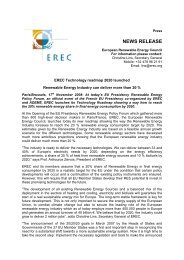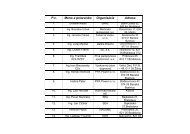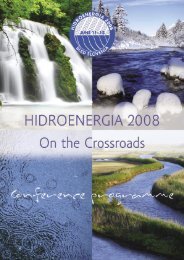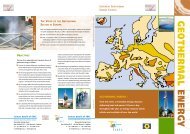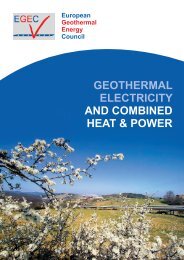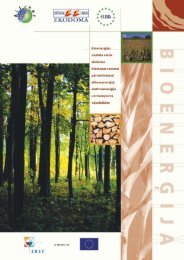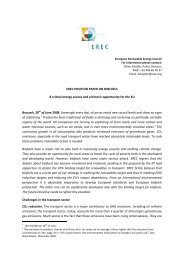CTO Assessment - European Commission
CTO Assessment - European Commission
CTO Assessment - European Commission
Create successful ePaper yourself
Turn your PDF publications into a flip-book with our unique Google optimized e-Paper software.
UPPER AUSTRIA<br />
a model for a<br />
RE REGION<br />
Contact: Christine Öhlinger •O.Ö Energiesparverband<br />
Linz, Upper Austria • Austria • Tel: + 43-732-7720-14380<br />
Email: office@esv.or.at • Website: www.esv.or.at<br />
A very proactive regional government put<br />
into place a regional energy strategy in<br />
1994. It continued in 2000 with a second<br />
phase called «Energy 21» which sets complementary<br />
objectives, consisting of 25<br />
concrete measures following a timetable.<br />
Thanks to this programme, the share of<br />
renewable energy sources (RES) increased<br />
in Upper Austria from 25 % in 1993 to<br />
more than 30% currently of the primary<br />
energy consumption.<br />
Main aims and motivations<br />
The main aim of the Upper Austrian energy<br />
strategy is that based on clear political<br />
commitment, an action plan which comprises<br />
a mix of measures targeting at different<br />
market actors, should be consequently<br />
implemented. The implementation<br />
of the action plan is done by the regional<br />
energy agency O.Ö. Energiesparverband,<br />
which is very close to the market actors.<br />
Besides the environmental benefits, the<br />
energy strategy also brings clear economic<br />
advantages for the region. Currently more<br />
than 10,000 jobs are secured by renewable<br />
energy sources. A network of companies<br />
working in the field of sustainable<br />
energy has been established in the region,<br />
where 133 partners are co-operating.<br />
These green energy businesses achieve a<br />
total turn-over of more than 235 million€<br />
and employ around 2,000 people.<br />
The initiative<br />
In 1994 concrete goals to reduce fossil fuel<br />
consumption by increasing both energy efficiency<br />
and the use of RES by 2000 were set<br />
and a comprehensive energy action plan was<br />
developed and implemented, which led to a<br />
significant market development of renewable<br />
energy sources and the achievement of the<br />
policy goals set by the energy strategy.<br />
In the year 2000, the Upper Austrian Government<br />
unanimously passed the second<br />
phase of the regional energy strategy, the<br />
«Energy 21», including again ambitious objectives<br />
to be met by the implementation of a<br />
clearly specified action plan consisting of 25<br />
concrete measures.<br />
O.Ö. Energiesparverband, the regional energy<br />
agency of Upper Austria is responsible<br />
for the implementation of most of the measures<br />
included in the action plan.<br />
As a result of the implementation of the energy<br />
strategy, the share of RES increased<br />
from 25 % to more than 30 %, featuring a<br />
leading position in modern biomass installations<br />
but also a number of other RES installations,<br />
e.g. solar thermal, PV plants, small<br />
hydro power plants, wind power plants, etc…<br />
Achievement by the end of 2002 in biomass<br />
A leading position in modern biomass installations:<br />
15,100 modern wood heating installations (852 MW)<br />
32 % of all Austrian wood chips installations<br />
200 biomass district heating plants<br />
4,500 wood pellets central heating installations<br />
27 % of all Austrian wood pellets installations<br />
12 large pellet producing companies<br />
15 companies producing biomass boilers & stoves<br />
Achievements in other sectors<br />
650,000 m² solar thermal collectors (7/2003), 470 m²/1000 inhabitants<br />
600 PV plants (2,600 kWp)<br />
> 500 small hydro power plants (< 10 MW)<br />
17 wind power plants (7/2003), 14.4 MW<br />
> 30 biogas and > 30 sewage gas plants<br />
geothermal energy (50 MW), one plant for electricity generation<br />
Main innovative aspects<br />
One main novel aspect of the Upper Austrian<br />
energy strategy is that it combines<br />
measures creating a demand for sustainable<br />
energy products and services while at<br />
the same time offers measures to meet the<br />
created demand appropriately.<br />
Enabling factors<br />
A number of well targeted support programmes<br />
were implemented in order to<br />
reach different target groups using different<br />
measures and targeting at the supply<br />
and the demand side, including for example:<br />
Creating «demand» for sustainable energy<br />
products and services: energy information<br />
and awareness raising, energy<br />
advice (15,000 energy advice sessions<br />
annually), seminars, conferences...<br />
Supply side: training & education, R&D<br />
programme, regional TPF-programme,<br />
quality control.<br />
Challenges<br />
One of the main challenges was to continue<br />
the successful development to reach<br />
the really ambitious objectives of the Energy<br />
21 strategy and to bring the positive<br />
market development also to other sectors. As<br />
an example, the ambitious aim in the biomass<br />
sector is to double modern biomass heating<br />
installations till 2010.<br />
In the year 2000, the Energy 21 strategy set<br />
the target of reaching 1,000,000 m² of solar<br />
thermal collectors by 2010 - equalling nearly<br />
1 m² per inhabitant!<br />
Replication potential<br />
The approach taken in Upper Austria can<br />
serve as an example for other regions and<br />
countries in Europe that a strategic approach<br />
based on a strong political commitment and<br />
a clear action plan can lead to a significant<br />
change in energy production and consumption.<br />
46 <strong>CTO</strong> - Showcase


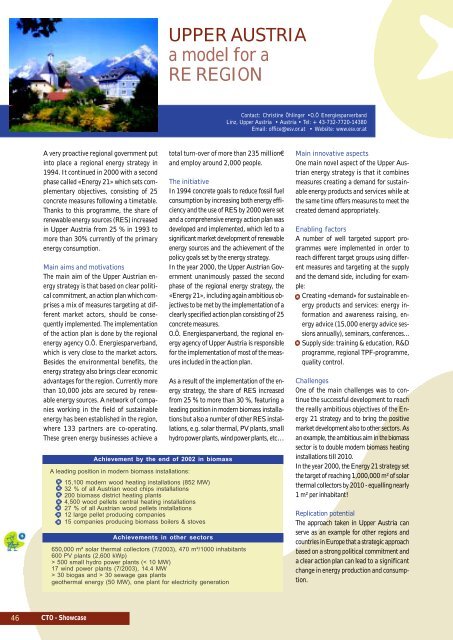
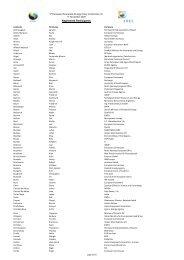
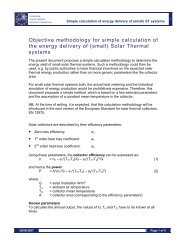
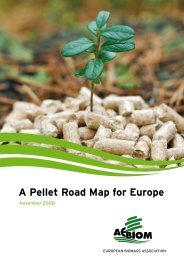
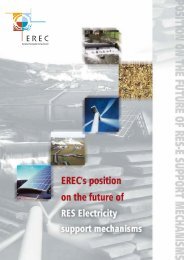

![Energy [R]evolution - Greenpeace](https://img.yumpu.com/47174859/1/184x260/energy-revolution-greenpeace.jpg?quality=85)
